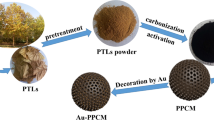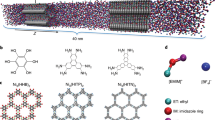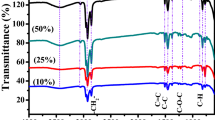Abstract
Lightweight, low-cost supercapacitors with the capability of rapidly storing a large amount of electrical energy can contribute to meeting continuous energy demands and effectively levelling the cyclic nature of renewable energy sources1. The excellent electrochemical performance of supercapacitors is due to a reversible ion adsorption in porous carbon electrodes. Recently, it was demonstrated that ions from the electrolyte could enter sub nanometre pores, greatly increasing the capacitance2,3,4. However, the molecular mechanism of this enhancement remains poorly understood. Here we provide the first quantitative picture of the structure of an ionic liquid adsorbed inside realistically modelled microporous carbon electrodes. We show how the separation of the positive and negative ions occurs inside the porous disordered carbons, yielding much higher capacitance values (125 F g−1) than with simpler electrode geometries5. The proposed mechanism opens the door for the design of materials with improved energy storage capabilities. It also sheds new light on situations where ion adsorption in porous structures or membranes plays a role.
This is a preview of subscription content, access via your institution
Access options
Subscribe to this journal
Receive 12 print issues and online access
$259.00 per year
only $21.58 per issue
Buy this article
- Purchase on Springer Link
- Instant access to full article PDF
Prices may be subject to local taxes which are calculated during checkout




Similar content being viewed by others
References
Miller, J. R. & Simon, P. Electrochemical capacitors for energy management. Science 321, 651–652 (2008).
Chmiola, J. et al. Anomalous increase in carbon capacitance at pore sizes less than 1 nm. Science 313, 1760–1763 (2006).
Raymundo-Piñero, E., Kierzek, K., Machnikowski, J. & Béguin, F. Relationship between the nanoporous texture of activated carbons and their capacitance properties in different electrolytes. Carbon 44, 2498–2507 (2006).
Largeot, C. et al. Relation between the ion size and pore size for an electric double-layer capacitor. J. Am. Chem. Soc. 130, 2730–2731 (2008).
Merlet, C., Salanne, M., Rotenberg, B. & Madden, P. A. Imidazolium ionic liquid interfaces with vapor and graphite: Interfacial tension and capacitance from coarse-grained molecular simulations. J. Phys. Chem. C 115, 16613–16618 (2011).
Simon, P. & Gogotsi, Y. Materials for electrochemical capacitors. Nature Mater. 7, 845–854 (2008).
Huang, J., Sumpter, B. G. & Meunier, V. Theoretical model for nanoporous carbon supercapacitors. Angew. Chem. Int. Ed. 47, 520–524 (2008).
Yang, L., Fishbine, B. H., Migliori, A. & Pratt, L. R. Molecular simulation of electric double-layer capacitors based on carbon nanotube forests. J. Am. Chem. Soc. 131, 12373–12376 (2009).
Shim, Y. & Kim, H. J. Nanoporous carbon supercapacitors in an ionic liquid: A computer simulation study. ACS Nano 4, 2345–2355 (2010).
Feng, G. A. et al. The importance of ion size and electrode curvature on electrical double layers in ionic liquids. Phys. Chem. Chem. Phys. 13, 1152–1161 (2011).
Kornyshev, A. A. Double-layer in ionic liquids: Paradigm change? J. Phys. Chem. B 111, 5545–5557 (2007).
Armand, M., Endres, F., MacFarlane, D. R., Ohno, H. & Scrosati, B. Ionic-liquid materials for the electrochemical challenges of the future. Nature Mater. 8, 621–629 (2009).
Lanning, O. & Madden, P. Screening at a charged surface by a molten salt. J. Phys. Chem. B 108, 11069–11072 (2004).
Fedorov, M. V. & Kornyshev, A. A. Ionic liquid near a charged wall: Structure and capacitance of electrical double layer. J. Phys. Chem. B 112, 11868–11872 (2008).
Vatamanu, J., Borodin, O. & Smith, G. D. Molecular insights into the potential and temperature dependences of the differential capacitance of a room-temperature ionic liquid at graphite electrodes. J. Am. Chem. Soc. 132, 14825–14833 (2010).
Fedorov, M. V. & Kornyshev, A. A. Towards understanding the structure and capacitance of electrical double layer in ionic liquids. Electrochim. Acta 53, 6835–6840 (2008).
Feng, G., Huang, J., Sumpter, B. G., Meunier, V. & Qiao, R. A ‘counter-charge layer in generalized solvents’ framework for electrical double layers in neat and hybrid ionic liquid electrolytes. Phys. Chem. Chem. Phys. 13, 14723–14734 (2011).
Bazant, M. Z., Storey, B. D. & Kornyshev, A. A. Double layer in ionic liquids: Overscreening versus crowding. Phys. Rev. Lett. 106, 046102 (2011).
Kondrat, S. & Kornyshev, A. A. Superionic state in double-layer capacitors with nanoporous electrodes. J. Phys. Condens. Matter 23, 022201 (2011).
Kondrat, S., Georgi, N., Fedorov, M. V. & Kornyshev, A. A. A superionic state in nanoporous double-layer capacitors: Insights from Monte Carlo simulations. Phys. Chem. Chem. Phys. 13, 11359–11366 (2011).
Palmer, J. C. et al. Modeling the structural evolution of carbide-derived carbons using quenched molecular dynamics. Carbon 48, 1116–1123 (2010).
Reed, S. K., Lanning, O. J. & Madden, P. A. Electrochemical interface between an ionic liquid and a model metallic electrode. J. Chem. Phys. 126, 084704 (2007).
Pounds, M., Tazi, S., Salanne, M. & Madden, P. A. Ion adsorption at a metallic electrode: An ab initio based simulation study. J. Phys. Condens. Matter 21, 424109 (2009).
Chmiola, J., Largeot, C., Taberna, P-L., Simon, P. & Gogotsi, Y. Desolvation of ions in subnanometer pores and its effect on capacitance and double-layer theory. Angew. Chem. Int. Ed. 47, 3392–3395 (2008).
Hardacre, C., Holbrey, J. D., Nieuwenhuyzen, M. & Youngs, T. G. A. Structure and solvation in ionic liquids. Acc. Chem. Res. 40, 1146–1155 (2007).
Ohkubo, T. et al. Restricted hydration structures of Rb and Br ions confined in slit-shaped carbon nanospace. J. Am. Chem. Soc. 124, 11860–11861 (2002).
Willard, A. P. & Chandler, D. Instantaneous liquid interfaces. J. Phys. Chem. B 114, 1954–1958 (2010).
Roy, D. & Maroncelli, M. An improved four-site ionic liquid model. J. Phys. Chem. B 114, 12629–12631 (2010).
Vora, P. M. et al. Correlating magnetotransport and diamagnetism of sp2–bonded carbon networks through the metal–insulator transition. Phys. Rev. B 84, 155114 (2011).
Acknowledgements
We acknowledge the support of the French Agence Nationale de la Recherche (ANR) under Grant ANR-2010-BLAN-0933-02 (‘Modelling the Ion Adsorption in Carbon Micropores’). We are grateful for the computing resources on Hector (UK National HPC) provided by EPSRC through the UKCP consortium. Y.G. is supported by the US National Science Foundation under International Collaborations in Chemistry Grant No. 0924570. P.S. and Y.G. thank the Partner University Fund (PUF) for funding their collaborative efforts. We thank J. C. Palmer and K. Gubbins for providing us the raw data from ref. 21.
Author information
Authors and Affiliations
Contributions
C.M., B.R., P.A.M. and M.S. designed the research. C.M. carried out simulations. All authors contributed to the analysis and discussion of the data and writing the manuscript.
Corresponding author
Ethics declarations
Competing interests
The authors declare no competing financial interests.
Supplementary information
Supplementary Information
Supplementary Information (PDF 813 kb)
Supplementary Information
Supplementary Information (MOV 2698 kb)
Supplementary Information
Supplementary Information (MOV 11351 kb)
Rights and permissions
About this article
Cite this article
Merlet, C., Rotenberg, B., Madden, P. et al. On the molecular origin of supercapacitance in nanoporous carbon electrodes. Nature Mater 11, 306–310 (2012). https://doi.org/10.1038/nmat3260
Received:
Accepted:
Published:
Issue Date:
DOI: https://doi.org/10.1038/nmat3260
This article is cited by
-
Accurate additive manufacturing of lightweight and elastic carbons using plastic precursors
Nature Communications (2024)
-
Comparison of 3D-cDFT and GCMC simulations for fluid–structure analysis in amorphous carbon nanoporous materials
Adsorption (2024)
-
Effect of carbon enrichment in polymer-derived ceramers on the electrochemical characteristics of their derived carbons
Journal of Materials Science (2024)
-
New low-cost, flow-through carbon electrodes characterized in brackish water
Chemical Papers (2023)
-
Unconventional interfacial water structure of highly concentrated aqueous electrolytes at negative electrode polarizations
Nature Communications (2022)



